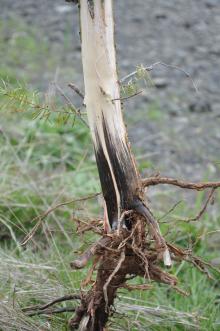Cause The fungus Leptographium wageneri var. pseudotsugae in young Douglas-fir stands west of the Cascade Range that have been thinned (especially in the interior areas of southwest Oregon) and Grosmannia wageneri (formerly L. wageneri var. ponderosum) on old ponderosa pine stands east of the Cascade Range. These fungi can move short distances from tree to tree via root-to-root contact or root grafts. Long distance spread is by a root-feeding bark beetle and two root and crown weevils. Insects breed in the dying roots of stressed trees even before crown symptoms are observed. Although neither is necessary for the other, if insects breed in an infected root system they can spread the fungus to new trees that do not have the disease. Generally found next to roads, in plantations that have been thinned and that have suffered severe soil disturbance during the harvest of the previous stand and in areas of disturbed soil drainage.
Symptoms Old needles are lost first followed by reduced terminal growth, chlorosis and sometimes a crop of stress cones before tree death. The black stain can be seen in the wood as broad streaks extending from the roots up the stem. In cross section it appears in crescents and follows the annual rings. Generally limited to one to three growth rings. Wood decay does not occur unless other fungi are present. The staining may fade once the tree dies. Basal resinosis or pitching (large exudations of pitch at the base of the stem at or below the root collar) may also occur.
Cultural control
- Favor resistant species.
- Plant at wide spacing to avoid pre-commercial thinning.
- Pre-commercial thinning is best done in the summer between June 1 and September 1 when bark beetles are not flying.
- Prevent tree wounding, soil disturbance, or other activities that decrease tree vigor.
Reference Shaw, D.C., Oester, P.T. and Filip, G.M. 2009. Managing Insects and Diseases in Oregon Conifers. Oregon State University Extension Service. EM 8980.

